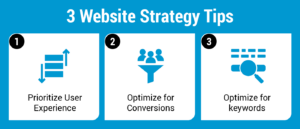
Nonprofit Website Tips: The Google Ad Grant Edition
If there’s one secret weapon you could add to your nonprofit marketing arsenal, it’s the Google Ad Grant. By equipping eligible nonprofits with $10,000 in ad credits each month, this program enables organizations to access more supporters and increase digital conversions.
While this program can be revolutionary for nonprofits, there are a few tasks your nonprofit needs to complete to harness the program’s full potential. One of these to-do’s is elevating your nonprofit website strategy so that when online visitors navigate to your site, they’ll be more likely to take action and support your cause.
In this guide, we’ll review quick tips you can implement to upgrade your website strategy and get the most out of the Google Ad Grant. But, before we dive in, let’s review why it’s important to upgrade your website strategy to begin with.
The importance of a strong website strategy
Google wants to reward worthy causes with increased web traffic. But, to do this, it needs to be sure your website is ready to receive a new influx of visitors. That’s why Google’s website policy outlines its expectations of a high-quality website, including elements like user experience and accessibility, which we will cover in more depth later.
If you meet these expectations, Google will approve your site and you’ll be on your way to accessing the full benefits of the grant. And, by adhering to these requirements, you’ll reap the following added benefits:
-
- Maintain Google Ad Grants eligibility. Google’s requirements stipulate that nonprofits must follow specific guidelines to achieve and maintain eligibility. Therefore, if you set your site up for success now and conduct regular audits, you’ll protect your status.
- Enhance your competitiveness. Aside from aligning with Google’s policies, a high-quality website can make your brand stand out within the crowded nonprofit digital space.
- Drive more conversions. A well-designed website can ultimately lead to more donations, volunteers, and event attendees, helping to fuel your cause.
- Increase your brand’s credibility. Your website is many online visitors’ first impression of your organization. So, a high-quality website speaks to your credibility and can be a deciding factor in their support.
Research suggests that users will spend an average of 15 seconds on a website before deciding if they’d like to stay or move on. You can make the most of these 15 seconds by ensuring your site is engaging and Google Ad Grant-ready with these three tips:
3 Website strategy tips to ensure eligibility

-
Prioritize user experience
In a broad sense, user experience (UX) describes online visitors’ interactions with your website’s content, layout, and products. Google’s website policy outlines a few different rules that impact UX. These rules can be broken down into the following categories:
- Navigation. Put yourself in a first-time web visitor’s shoes, if they were to navigate to your site, would they find what they need quickly? Consider editing your navigation bar to include only your most important pages such as your About Page, donation form, and calendar of events.
- Loading times. It’s estimated that 40% of visitors will leave a website if it takes longer than three seconds to load. You can speed up your load times by optimizing your image formats and using an adaptable and straightforward nonprofit CMS.
- Broken links. A broken link leads to a page that no longer exists. You can amend these by implementing a redirect any time you take down a web page. For example, if you take down a previous event registration page, you can add a redirect to your current event calendar.
- Relevant content. Google’s guidelines note that your site “must have a robust and clear description of your organization, mission, and activities.” To accomplish this, you need to ensure your website includes relevant, mission-related content. This includes a link to your annual reports, a built-out About Page, and an updated events calendar at minimum.
By refreshing your site with these factors in mind, you’ll set your visitors up for a positive experience. This way, when they click on your Google Ads, they’ll be more likely to take the next step and support your cause.
2. Optimize for conversions
Your website is a main channel for incoming donations. This means website visitors need to be able to quickly identify where and how they can financially support you. You can meet this need by incorporating a thoughtful “call to action” (CTA) strategy.
CTAs anticipate a user’s next actions by providing relevant links to related information. You can optimize your CTA strategy and bring in more conversions by:
- Ensuring CTAs are contextually relevant. For example, your newsletter promotion might include a CTA with the phrase “Sign up today.”
- Keeping your CTA buttons clear and concise. Short, straightforward phrases like “Donate Now” indicate that users will be brought to your donation page.
- Adding accessible design. Use contrasting colors to bring attention to your CTAs so users don’t miss a chance to convert.
Vary your CTA strategy throughout your website to offer value at different stages of the conversion funnel. For instance, your About Page could feature CTAs that lead supporters to learn more with resources like beneficiary testimonials or a calendar of upcoming fundraising events. On the other hand, your Get Involved page could feature a CTA that leads to your donation page.
3. Optimize for keywords
Google outlines specific keyword restrictions that dictate the quality and length of keyword phrases. These keywords refer to the search terms users enter into Google that generate search results pages. For instance, a user could search “animal shelter near me” and then be directed to a closeby animal shelter’s volunteer page.
To steer clear of violating keyword restrictions and give yourself the best chance of increasing web traffic, Getting Attention recommends selecting a keyword with the following attributes:
- High search volume. This refers to the number of people searching for this key term. If a nonprofit keyword describes your page, but no one is searching for it, you will not receive any conversions.
- Hyper-relevance. Your keywords must directly relate to your landing pages (the pages that your Google Ads direct to). For example, if a user clicks on a Google Ad triggered by the keyword “ocean conservation efforts,” a relevant landing page could be an overview of a conservation-based capital campaign.
- Low competition. Sometimes a keyword with a high search volume will also have a high competition rate. This means many nonprofits are using this term to promote their cause. You want to look for terms that hit the sweet spot between high search volume and low competition.
You can conduct keyword research by using tools like Moz Keyword Explorer or SEMRush to guide your selection. Or, you can partner with a Google Ad Grant Manager to help you determine hyper-relevant keywords that align with your cause and pave the way for increased conversions.
Then, once you’ve chosen your terms, you can thread them throughout your Google Ad copy and website content. This way, you’ll maintain relevant connections between your Google Ads and linked landing pages.
By incorporating these three tips into your website strategy, your online presence will be Google Ad Grant-ready. However, once you’ve refined your existing site, don’t just “set it and forget it.” Instead, continue to track your website metrics such as click-through rate to measure your ad performance.
Then, make necessary adjustments such as tweaking your landing page copy or increasing accessibility to offer a more positive user experience. That way, you’ll encourage new leads and convince existing supporters to come back again and again.


